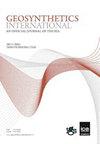Investigation on dynamic performance of soilbag cushion using shaking table tests
IF 3.3
2区 工程技术
Q2 ENGINEERING, GEOLOGICAL
引用次数: 0
Abstract
Soilbag cushion is one of the promising base isolation methods to reduce seismic energy transfer from ground to building structure. In this study, a series of shaking table tests were conducted comparatively on foundation models with soilbag cushion and sand cushion to evaluate their dynamic performance. The test results indicate that soilbag cushion could significantly reduce acceleration response and accumulated settlement compared to sand cushion. And the relatively smaller amplitude of dynamic lateral earth pressure measured on contact surface of soilbags within soilbag cushion also indicates its stability during oscillation. The advantages of soilbag cushion for energy dissipation and damping are more easily highlighted under the condition of high-acceleration, high-frequency or high uniformly distributed load. The dynamic performance of soilbag cushion is dependent on embedded depth and thickness. It is most effective for soilbag cushion to be arranged near the rigid footing of building structures; it is suggested that the number of layers of soilbag cushion be controlled on the premise of the designed ratio of the thickness to the width of soilbag cushion ranging from 0.125 to 0.4 for low- or middle-rise masonry buildings in practical engineering.用振动台试验研究土袋垫的动力性能
土袋垫层是一种很有前途的基础隔震方法,可以减少地震能量从地面传递到建筑结构。本研究对土袋垫层和砂垫层地基模型进行了振动台对比试验,对其动力性能进行了评价。试验结果表明,与砂垫层相比,土袋垫层能显著降低土体的加速度响应和累积沉降。在土袋垫层内部土袋接触面测得的动侧土压力幅值相对较小,也说明了土袋垫层在振荡过程中的稳定性。在高加速度、高频或高均布荷载条件下,土袋垫的耗能和阻尼优势更容易凸显。土袋垫层的动力性能与埋置深度和厚度有关。土袋垫层布置在建筑结构刚性基础附近最有效;建议在实际工程中,对于中低层砌体建筑,在土袋垫层厚度与宽度的设计比为0.125 ~ 0.4的前提下,控制土袋垫层的层数。
本文章由计算机程序翻译,如有差异,请以英文原文为准。
求助全文
约1分钟内获得全文
求助全文
来源期刊

Geosynthetics International
ENGINEERING, GEOLOGICAL-GEOSCIENCES, MULTIDISCIPLINARY
CiteScore
6.90
自引率
20.00%
发文量
91
审稿时长
>12 weeks
期刊介绍:
An online only, rapid publication journal, Geosynthetics International – an official journal of the International Geosynthetics Society (IGS) – publishes the best information on current geosynthetics technology in research, design innovation, new materials and construction practice.
Topics covered
The whole of geosynthetic materials (including natural fibre products) such as research, behaviour, performance analysis, testing, design, construction methods, case histories and field experience. Geosynthetics International is received by all members of the IGS as part of their membership, and is published in e-only format six times a year.
 求助内容:
求助内容: 应助结果提醒方式:
应助结果提醒方式:


